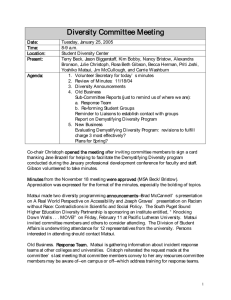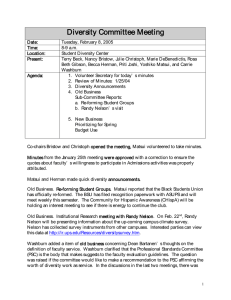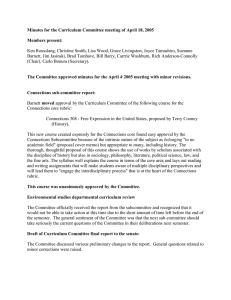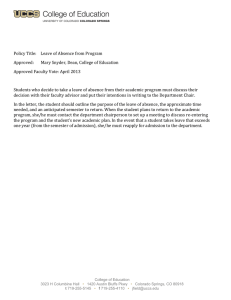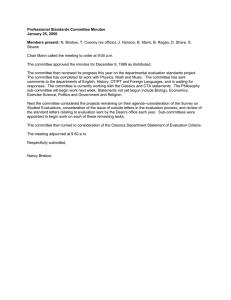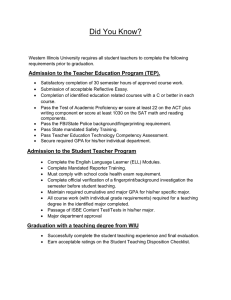Diversity Committee Meeting
advertisement
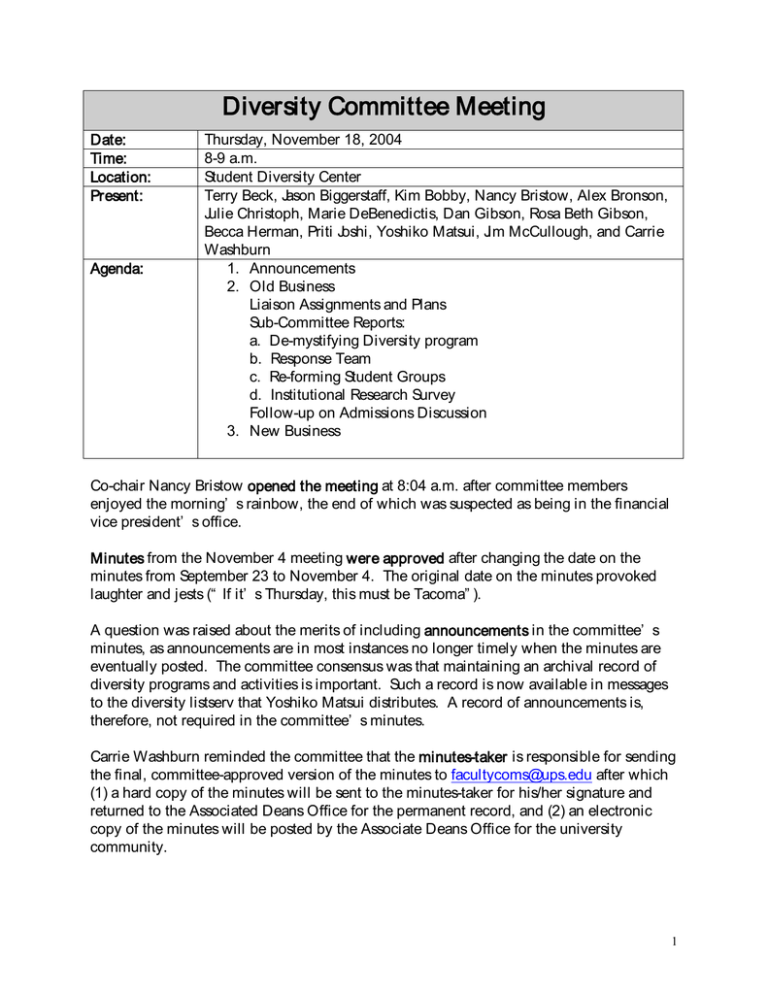
Diversity Committee Meeting Date: Time: Location: Present: Agenda: Thursday, November 18, 2004 8-9 a.m. Student Diversity Center Terry Beck, Jason Biggerstaff, Kim Bobby, Nancy Bristow, Alex Bronson, Julie Christoph, Marie DeBenedictis, Dan Gibson, Rosa Beth Gibson, Becca Herman, Priti Joshi, Yoshiko Matsui, Jim McCullough, and Carrie Washburn 1. Announcements 2. Old Business Liaison Assignments and Plans Sub-Committee Reports: a. De-mystifying Diversity program b. Response Team c. Re-forming Student Groups d. Institutional Research Survey Follow-up on Admissions Discussion 3. New Business Co-chair Nancy Bristow opened the meeting at 8:04 a.m. after committee members enjoyed the morning’ s rainbow, the end of which was suspected as being in the financial vice president’ s office. Minutes from the November 4 meeting were approved after changing the date on the minutes from September 23 to November 4. The original date on the minutes provoked laughter and jests (“ If it’ s Thursday, this must be Tacoma” ). A question was raised about the merits of including announcements in the committee’ s minutes, as announcements are in most instances no longer timely when the minutes are eventually posted. The committee consensus was that maintaining an archival record of diversity programs and activities is important. Such a record is now available in messages to the diversity listserv that Yoshiko Matsui distributes. A record of announcements is, therefore, not required in the committee’ s minutes. Carrie Washburn reminded the committee that the minutes-taker is responsible for sending the final, committee-approved version of the minutes to facultycoms@ups.edu after which (1) a hard copy of the minutes will be sent to the minutes-taker for his/her signature and returned to the Associated Deans Office for the permanent record, and (2) an electronic copy of the minutes will be posted by the Associate Deans Office for the university community. 1 2. Old Business. Liaison Assignments and Plans. Julie Christoph passed around the list of student clubs and organizations so that committee members who had not yet signed up to be liaisons could do so. Committee members serving as liaisons to student clubs and organizations will contact the president and the advisor of the club or organization and request to attend the group’ s first spring semester meeting. The diversity committee member will serve as a connection between the committee and the club or organization, not an advisor. Early in the spring semester meeting we will introduce ourselves and encourage the groups to be aware of the committee’ s interest in their work, our presence on campus, and our willingness to assist them if needed. Matsui indicated that we can find the names of officers and advisors on the ASUPS neighborhood web site if we enter through the member link. 2. Old Business. Sub-committee Reports. A. De-mystifying Diversity Program. Bristow announced that the program has been scheduled for Tuesday, January 11, from 8:15 to 9:45 a.m. and that she, Christoph, and Jane Brazell will be the facilitators. Rosa Beth Gibson distributed copies of the brochure describing the January 2005 Professional Development Conference for Faculty and Staff, thanked the committee for their program, and pointed out other diversity-related programs that will be offered during the conference—I am Puget Sound, Depression in the Workplace, Working with the Differently-abled Employee, and M.E.E.T. on Common Ground. Gibson invited committee members to encourage their faculty and staff colleagues to attend the Diversity Committee’ s program and other programs offered during the conference. 2. Old Business. Sub-committee Reports. B. Response Team. Bristow invited committee members to convey to Christoph and to her any resources committee members may be aware of—on campus or off—which address training for response teams. 2. Old Business. Sub-committee Reports. C. Reforming Student Groups. Matsui and Kim Bobby continue to meet with those students who are most likely to be interested in reforming student groups. Two events are scheduled—a game night in December and a meeting with alums for students of African descent. Marie DeBenedictis indicated that she needs to pull away from this sub-committee because of her work schedule. Because student groups will be formed or reformed authentically from the dialogue sessions Matsui and Bobby have orchestrated, all committee members will eventually be phased out, providing only behind-the-scenes support. Bristow encouraged Matsui and Bobby to call on committee members if there is anything that we can do, including routine calls and clerical tasks. 2. Old Business. Sub-committee Reports. D. Institutional Research Survey. Washburn indicated that Institutional Research will conduct a survey in the fall of 2005. Randy Nelson will consult with the committee as he constructs the survey instrument. 2 As Washburn had the floor, she interjected a request that committee members apprise her of their spring semester schedules (only fixed classes and meetings) so that she can identify a meeting day and time for the spring semester. 2. Old Business. Follow-up on Admissions Discussion. Washburn indicated that Director of Freshman Admission Melanie Reed had written to Academic Vice President and Dean Kris Bartanen asking Dean Bartanen to write to the faculty to request their participation in recruitment of students of color by providing a list of all of the ways faculty can partner with Admission colleagues in support of the recruitment and enrollment of students of color. Washburn also identified this as one of those activities/programs that the committee can spin off to a university department, in this case Admission. The committee won’ t, for example, have to coordinate the calling/e-mailing program for students of color who have been admitted to Puget Sound. Considerable discussion followed regarding how the university might encourage faculty members to act on such an invitation from the Dean. Ideas generated and points of view represented during the discussion included: Clearly identifying activities like supporting Admission in the recruitment and enrollment of students of color as university service Affirming through a public forum announcement from President Ron Thomas and Dean Bartanen that supporting Admission in the recruitment and enrollment of students of color is university service that they consider to be an institutional priority Committee co-chairs’ discussing with Dean Bartanen ways in which the importance of this service can be emphasized Recommending formally to the Professional Standards Committee that admission and other diversity-related activities be identified in evaluation guidelines as important forms of university service to be given weight by the Advancement Committee in their deliberations regarding tenure and promotion Because new faculty are already told to put “ everything” they do in a file from which to develop their personal statements, changing the formal evaluation process is not required—faculty already know to and do put informal and formal diversityrelated service in their personal statements Identifying diversity as a major institutional initiative like civic engagement so that faculty will see that diversity service is valued Formally adding demonstrating a commitment to diversity to the faculty (and staff) evaluation process, either so that the faculty member is required to identify how she/he demonstrated a commitment to diversity during the review period or so that such matters are threaded through statements on teaching, scholarship, and service Formally requesting that the Faculty Senate take up the subject of addressing diversity in the faculty evaluation process Recognizing that university faculty are already overloaded, identifying what is valued by the university so that faculty members can prioritize as they make choices about what to participate in 3 Recognizing that faculty of color have an invisible burden and developing a cultural climate in which that’ s understood Construing service more broadly than is currently the case, identifying service as an institutional governance issue and recognizing that finding faculty to serve on standing committees is daunting, especially with the recent creation of new standing committees DeBenedictis and Terry Beck added to the agenda another item of old business—a brief review of last year’ s Demystifying Diversity Program and of the program Beck and Grace Livingston facilitated during new faculty orientation. DeBenedictis began by indicating that last year’ s facilitators of Demystifying Diversity used the university’ s Diversity Statement to structure the program and opened with multicultural bingo as an ice breaker. She indicated that they didn’ t have prizes last year and Gibson suggested that HR would provide prizes for the 2005 program. DeBenedictis said that the facilitators didn’ t spend lots of time on the handouts they provided. For example, on the cultural identity handout they focused on item eight, something you’ ve done that was culturally inappropriate. The group discussed the best to worst in descriptions of multiculturalism—tossed salad versus melting pot, for example. The three facilitators took turns during the program. When DeBenedictis referenced co-facilitator David Macey, Jason Biggerstaff voiced the committee’ s disappointment that Macy is in Oklahoma rather than at Puget Sound. In small groups last year’ s workshop participants worked with one sentence from the diversity statement, discussing ways make the sentence concrete. Beck identified the origins of his and Livingston’ s program at new faculty orientation as in their own relationship-building experience as colleagues in the School of Education. Whereas Beck approached relationship building without structure, Livingston approached relationship building structurally, not ignoring the reality of the experience of participants. Recognizing this positionality was the focus of the program Beck and Livingston facilitated for faculty during new faculty orientation. The objective of their program was to help faculty to empower students of color, whom faculty often unconsciously and unintentionally ignore, dismiss, or ask to represent their race/ethnicity in classroom discussions. Conversations about empowering students of color continued well after the formal session. Committee members expressed keen interest in offering such a program again during new faculty orientation and in forums for other faculty and staff. McCullough moved and Beck seconded adjournment at about 9 a.m. Action Items Item Contact student clubs and organizations; schedule attendance at first meeting of spring semester Person Responsible Date Due Each committee member with liaison responsibilities Before the end of the fall semester 4 Send November 4 meeting minutes to facultycoms@ups.edu Send spring semester class schedules to cwashburn@ups.edu Consult with Dean Bartanen about her letter to faculty regarding support for admission of students of color Next Meeting: Jim MuCullough ASAP Each committee member Bristow and Christoph ASAP To be determined by Bristow and Christoph Thursday, December 2, 2004, 8 to 9 a.m., Student Diversity Center Respectfully submitted, Rosa Beth Gibson 5
